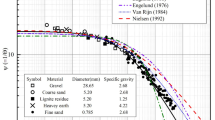Abstract
It is of great significance to study the process and cause of embankment dam breach in order to ensure the dam safety. In this paper, the overtopping failure mode of embankment dam is selected as the research object, and the cellular automata (CA) method is introduced to explore the development law and influencing factors of the overtopping failure mode. Based on the physical and mechanical characteristics of embankment dam and the energy evolution law of the dam soil failure process, this paper discusses the realization method of CA for simulations of dam body heterogeneity, soil anisotropy, stress environment, etc., and proposes the determination method of cellular failure threshold, energy dissipation rate and energy transfer coefficient. Afterward, the loading mode of the CA model is determined based on the relationship between generalized energy and force deformation of the dam soil. Then, energy criterion for dam erosion failure and mechanical criterion of breach slope failure are put forward. Finally, the CA model is applied to a practical project so as to analyze the development and cause for scour depth and width of the overtopping failure breach, and the influence of overtopping water level and downstream slope ratio on the development of breach.






























Similar content being viewed by others
References
Alberti M, Waddell P (2000) An integrated urban development and ecological simulation model. Integr Assess 1(3):215–227
Asghari Tabrizi A, Elalfy E, Elkholy M, Hanif Chaudhry M, Imran J (2017) Effects of compaction on embankment breach due to overtopping. J Hydraul Res 55(2):236–247
Biham O, Alan Middleton A, Levine D (1992) Self-organization and a dynamical transition in traffic flow models. Phys Rev A 46(10):R6124–R6127
Billstein M, Svensson U, Johansson N (1999) Development and validation of a numerical model of flow through embankment dams—comparisons with experimental data and analytical solutions. Transp Porous Media 35(3):395–406
Biondini F, Bontempi F, Frangopol DM, Malerba PG (2004) Cellular automata approach to durability analysis of concrete structures in aggressive environments. J Struct Eng 130(11):1724–1737
Cai X, Li Y, Wu W (2013) Cellular automaton model of flood submergence based on bulk method. J Hydroelectr Eng 32(5):30–34, 40
Chen SS (2012) Mechanism of embankment dam breach and simulation of failure process. China Water Power Press, Beijing
Chetti A, Benamar A, Hazzab A (2016) Modeling of particle migration in porous media: application to soil suffusion. Transp Porous Media 113(3):591–606
Clarke KC, Hoppen S, Gaydos L (1997) A self-modifying cellular automaton model of historical urbanization in the San Francisco Bay area. Environ Plan B 24:247–261
Ferdos Farzad, Wörman Anders, Ekström Ingvar (2015) Hydraulic conductivity of coarse rockfill used in hydraulic structures. Transp Porous Media 108(2):367–391
Fread DL (1988) BREACH: an erosion model for earthen dam failure. Silver Spring: National Weather Service (NWS) Report, MA NOAA
Gregorio SD, Rongo R, Serra R et al (2012) Simulation of water flow through a porous soil by a cellular automaton model. Neural Comput Appl 21(6):1191–1204
Hernández Zubeldia E, Ozelim LCSM, Luís Brasil Cavalcante A, Crestana S (2016) Cellular automata and X-ray microcomputed tomography images for generating artificial porous media. Int J Geomech 16(2):04015057
Khalilzad M, Gabr MA, Hynes ME (2015) Deformation-based limit state analysis of embankment dams including geometry and water level effects. Int J Geomech 15(5):04014086
Murray AB, Paola C (1994) A cellular model of braided rivers. Nature 371(6492):54–57
Radhakrishnan P, Mathew TV (2013) Hybrid stochastic cellular automata-driver-vehicle-object simulation model for heterogeneous traffic at urban signalized intersections. J Comput Civ Eng 27(3):254–262
Ravazzani G, Rametta D, Mancini M (2011) Macroscopic cellular automata for groundwater modelling. Environ Model Softw 26(5):634–643
Rifai I, Erpicum S, Archambeau P, Violeau D, Pirotton M, El Kadi Abderrezzak K, Dewals B (2017) Overtopping induced failure of noncohesive, homogeneous fluvial dikes. Water Resour Res 53:3373–3386
Soares-Frazaoa S, Zech Y (2008) Dam-break flow through an idealized city. J Hydraul Res 46(5):648–658
Su HZ, Hu J, Wen ZP (2013) Optimization of reinforcement strategies for dangerous dams considering time-average system failure probability and benefit–cost ratio using a life quality index. Nat Hazards 65(1):799–817
Wahl TL (2004) Uncertainty of predictions of embankment dam breach parameters. J Hydraul Eng 130(5):389–397
Wang LH, Hu SY (2007) Review of dam failure. Adv Sci Technol Water Resour 27(1):80–85
Wolfram S (1983) Statistical mechanics of cellular automata. Rev Mod Phys 55(3):601–644
Wu ZR, Su HZ, Guo HQ (2008) Risk assessment method of major unsafe hydroelectric project. Sci China Technol Sci 51(9):1345–1352
Yin L, Zhu J, Wang J (2015) Real-time simulation and analysis of dam-break flood routing based on GPU-CA model. Geomat Inf Sci Wuhan Univ 40(8):1123–1129, 1136
Zhang JY, Li Y, Xuan GX et al (2009) Overtopping breaching of cohesive homogeneous earth dam with different cohesive strength. Sci China Technol Sci 52(10):3024–3029
Zhang S, Yuan R, Wu Y, Yi Y (2016) Parallel computation of a dam-break flow model using OpenACC applications. J Hydraul Eng, 04016070
Acknowledgements
This research has been partially supported by the National Natural Science Foundation of China (SN: 51979093, 51739003, 51579083), the National Key Research and Development Program of China (SN: 2019YFC1510801, 2018YFC0407101, 2016YFC0401601, 2017YFC0804607), the Key R&D Program of Guangxi (SN: AB17195074) and the Open Foundation of State Key Laboratory of Hydrology-Water Resources and Hydraulic Engineering (SN: 20195025912, 20165042112).
Author information
Authors and Affiliations
Corresponding author
Additional information
Publisher's Note
Springer Nature remains neutral with regard to jurisdictional claims in published maps and institutional affiliations.
Rights and permissions
About this article
Cite this article
Su, H., Qian, C., Wen, Z. et al. Cellular automata model-based numerical analysis for breaching process of embankment dam. Nat Hazards 103, 251–282 (2020). https://doi.org/10.1007/s11069-020-03986-x
Received:
Accepted:
Published:
Issue Date:
DOI: https://doi.org/10.1007/s11069-020-03986-x



